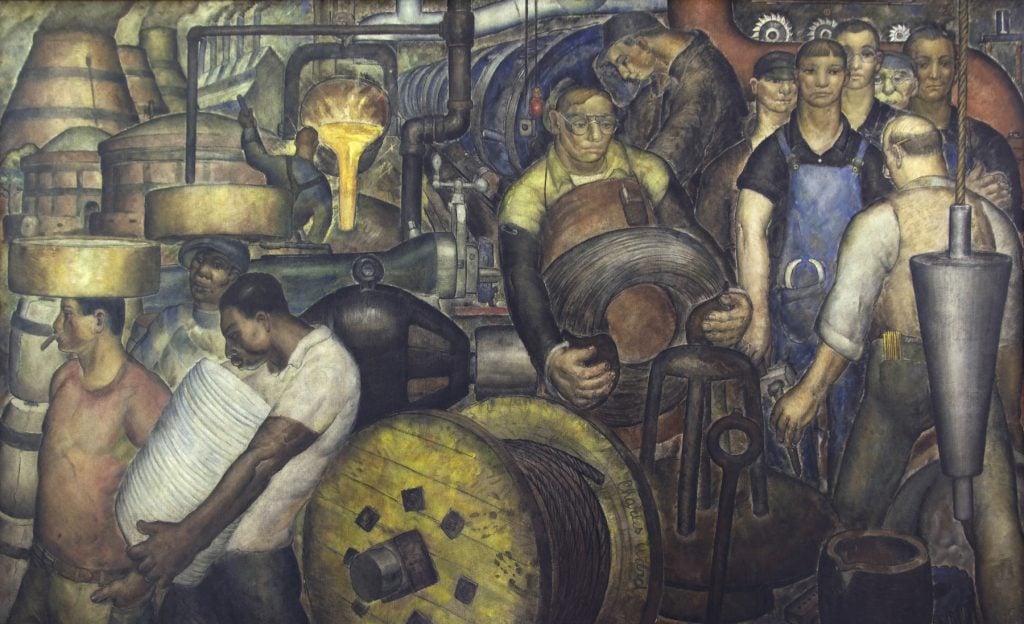Law & Politics
Lawmakers in Congress Want to Put Unemployed Artists Back to Work With a $300 Million Bill to Fund Public Cultural Projects
The bill was inspired by the New Deal's Works Progress Administration.

The bill was inspired by the New Deal's Works Progress Administration.

Taylor Dafoe

Looking to the New Deal for inspiration, lawmakers in Congress have proposed $300 million in workforce grants that would put unemployed art workers back on the job.
Inspired by the Works Progress Administration (WPA), the Creative Economy Revitalization Act, or CERA, would establish a program within the Workforce Innovation and Opportunity Act that would give grants to artists and cultural organizations for public projects. The funds, which would come from department of labor in coordination with the National Endowment for the Arts, would have to go toward forms of art that are freely open to all, such as public murals, exhibitions, and concerts.
Representatives Teresa Leger Fernández of New Mexico and Jay Obernolte of California introduced the bipartisan bill to the House of Representatives in August, while Senator Ben Ray Luján, also of New Mexico, brought it to the Senate floor last Tuesday, September 28.
In both branches, CERA boasts the support of lawmakers on both sides of the aisle. More than 175 arts organizations, including Americans for the Arts, Arts Workers United, and the Native Arts and Cultures Foundation, have also endorsed the bill.
The WPA put artists back to work after the Great Depression and preserved generations of history through art.
Today, I introduced the Creative Economy Revitalization Act to do just that. Let’s get artist back to work after this pandemic. pic.twitter.com/Tmnuk0yjGE
— Rep. Teresa Leger Fernández (@RepTeresaLF) August 13, 2021
“This pandemic has devastated our creative workers and we must engage them to create art that unites and brings joy to our communities,” said Leger Fernández in a statement. “In a time when our nation is so divided, we desperately need to be reminded of what makes our communities beautiful and diverse. This bill will provide grants to help fund projects that bring communities back together and remind us of what binds us together as Americans.”
Nearly two-thirds of creative workers were jobless at the peak of the pandemic last year, the congresswoman pointed out. The entire creative sector, meanwhile, has lost an estimated $15 billion dollars since March of 2020.
Creative workers are among the hardest hit by the COVID-19 pandemic. That's why I'm leading legislation with @RepTeresaLF to bolster the creative economy and provide relief for artists and writers to help them recover and rebuild.
More ⤵️https://t.co/g0Zrw6l9vY
— Ben Ray Luján (@SenatorLujan) September 28, 2021
While there is no recent precedent on the federal level, various cities have implemented their own WPA-style grant programs to aid art workers left jobless by the pandemic. In May, New York Mayor Bill de Blasio announced a $25 million economic recovery initiative that would see the city commission 1,500 artists to create public artworks. Chicago previously launched its own $60 million arts recovery program
In January of this year, mayors from 10 U.S. cities, including Los Angeles, San Francisco, and Chicago, co-wrote a letter urging President Biden to allocate funding for the arts in his developing stimulus plan. When that $1.9 trillion relief bill was passed by Congress in March, it contained $470 million for cultural organizations. The President’s follow-up infrastructure bill, still being hammered out in congress, does not contain funding for the arts.